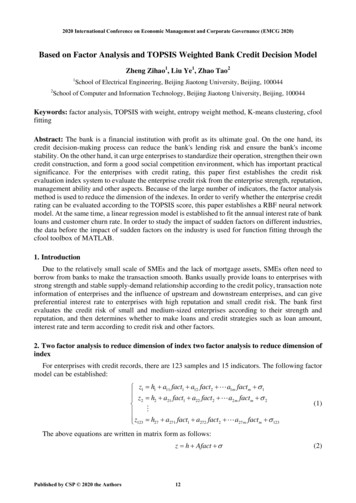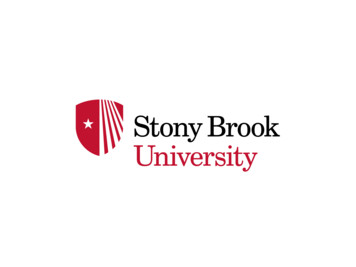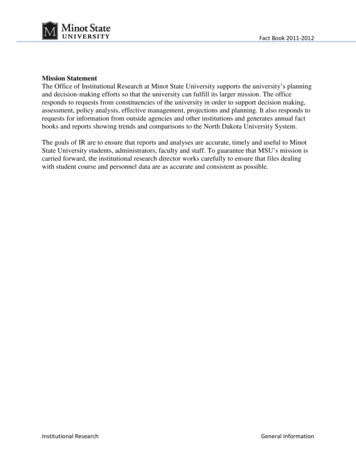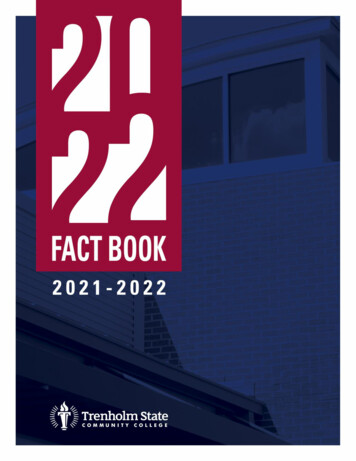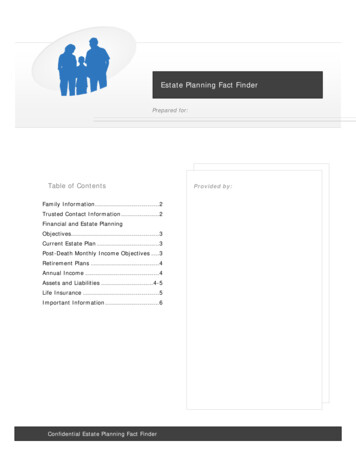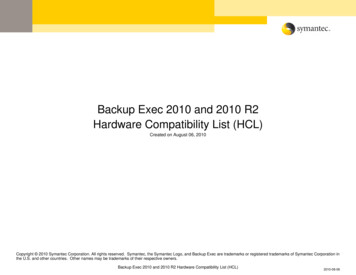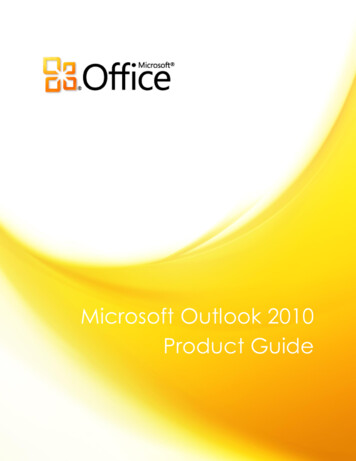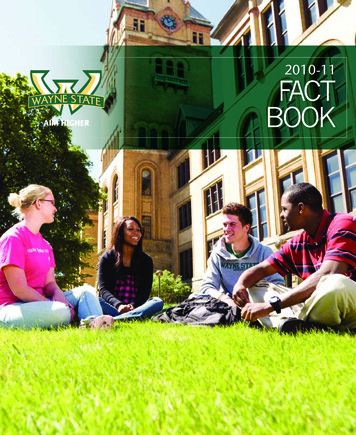
Transcription
2010-11AIM HIGHERFACTBOOK
Fast factsWayne State University is classified by the Carnegie Foundation for the Advancement of Teaching asRU/VH (Research University, Very High research activity), a distinction held by only 3.6 percent ofinstitutions of higher education in the United States. It has 13 colleges and schools and offers morethan 400 academic programs including bachelor’s, master’s and doctoral degrees; post-baccalaureate,graduate and specialist certificates; and three professional programs.Fall 2010 enrollment by ,4422,22631,505Fall 2010 credit hours by 55,19942,254327,0722010 – 2011Annual tuition and enured/tenure-track1,044LibrariesPurdy/Kresge LibraryArthur Neef Law LibraryScience and Engineering LibraryDavid Adamany Undergraduate LibraryOakland Center LibraryShiffman Medical LibraryUndergraduate – lower division (24 credit hours)Resident 7,295Non-resident 15,455ResearchGraduate (24 credit hours)ResidentNon-residentReal estate acreage 12,725 26,614Fall 2010 housing and residential life(based on 15 meals per week plan)Freshman 7,500 (2 person room)Housing occupancyResidence hallsApartmentsTotal1,7391,0292,768Degrees awarded in FY 2009-10by Total2,4892,0317175,237Current funds revenue FY 2010Tuition and fees, netGrants and contractsState appropriationsOtherTotal 304 M 309 M 220 M 63 M 896 M2010 Number of awards2010 Award dollars1,082 182.2MMain campus: 210 acresResearch and technology park: 43 acresExtension centersAdvanced Technology Education Center, WarrenHarper Woods Center, Harper WoodsMacomb Education Center, Clinton TownshipOakland Center, Farmington HillsSt. Clair Community College, Port HuronUniversity Center – Macomb, Clinton TownshipFounded in: 1868President: Allan GilmourUniversity accreditation:North Central Association of Colleges and SchoolsLocation and homepage addressWayne State UniversityDetroit, Michigan 48202(877) WSU-INFOwayne.eduApply onlineadmissions.wayne.edu
IntroductionThe Wayne State University Fact Book is a formal compilation of detailedinformation about the University’s purpose, resources, activities and people.The Fact Book is relevant and useful to current and prospective students,faculty, staff, alumni, the media and others with an interest in the University.The information has been compiled by the WSU Office of Budget,Planning and Analysis. Your comments or suggestions are welcome. Call(313) 577-2001 or e-mail budget@wayne.edu. An electronic versionof this document is available at wayne.edu/facts.
New Center AreaWest Grand BoulevardFisher BuildingNAmsterdam6110 CassTechOneBurroughsNextEnergyOneFordPlace5900 Second Ave.Cohn rWSUBookstoreScience HallPSimonsThompsonHomePParkingStructure 8PWayne State ld77 W. CanfieldScottShiffman LibraryMed. Ed. Commons HallHudson/WeberCancer Bldg.WillisPto RenaissanceCenterMax M. FisherMusic Center101 E. tact (313) 577-2280 for assistance with accessibility at WSUHutzelHospitalForestThe Children’sCenterTechTownBrushDetroit VAMedical CenterNon-WSUCultural CenterMottCenterPGeneral ParkingParking LotsPMackParkingStructure armacy andHealth SciencesBuildingUniversityHealthCenterBrush ParkHancockStudioOneApts.University TowerPrentisSt. AntoinePParkingStructure 4ThirdHilberryTheatre76 and 60W. HancockLandeDetroitReceivingHospitalP110 E. WarrenWDETWSU Medical Campus/Detroit Medical CenterDetroitScience CenterJohn RCassOldMainMackenzieForestwayne.eduCharles H. WrightMuseum ofAfrican AmericanHistoryParkingStructure 3MarwilBookstorePHancockTheatre ructure6WarrenPBrushUnderground parkingPutnamScience and elopmentCenterPDetroitInstituteof ArtsSt. AntoinePrentisDetroitPublicLibraryWoodward on MallEngineeringKirbyReutherLibraryState HallLeon H. AtchisonResidence HallUndergraduateLibraryGullen MallYousif B. GhafariResidence HallPKirbyPurdyFountainCourtWilliams MallKnappFerryThe Innon ation andFitness CenterChatsworthApts.DeRoyApts.Anthony Wayne DriveSt. Andrew ’sPFreer House5435Woodward5425WoodwardReuther MallKresgeBeecherHouseJohn REducationSkillmanPWoodward Ave.McGregorStudentCenterPParkingStructure 2PalmerPMusicFaculty/AdministrationBuildingJohn rry MallTheTowersManoogianay (I-94)Ford FreewCustodial/GroundsBuildingArt ringPComputingServicesCenterC& ITPPLaw SchoolKirbyEngineeringTechnologyPParkingStructure 1PParkingStructure5PP)y (I-94reewaFord FPPPAntoinetteAntoinetteJohn C. Lodge Freeway (M-10)John C. Lodge Service DriveAdams FieldTrumbullStadium erTrumbullHarperChildren’sHospital ofMichiganChrysler Freeway ( I-75)Lodge Freeway (M-10)YorkPPP6001 CassFord Freeway (I-94)MatthaeiPhysicalEducationCenterPWSU PoliceDepartmentChrysl er Freeway ( I-75)TechTown Researchand Technology Park
Table of ContentsAbout WSUStrategic visionOur visionOur missionOur goalsAccreditationImpact on MichiganEconomic impactNotable contributions and programsWayne State University notable events1122233346The Students9What is WSU’s enrollment?Who are WSU’s students?Who are WSU’s new undergraduate students?What is the age of the WSU student population?Where do WSU’s students come from?How many out-of-state and international students attend WSU?How many credits do WSU students typically take per semester? What percentage of freshman students return to the Universityfor a second year?How many degrees and certificates were granted last year?9101213141517Schools and CollegesSchool of Business AdministrationCollege of EducationCollege of EngineeringCollege of Fine, Performing and Communication ArtsIrvin D. Reid Honors CollegeLaw SchoolCollege of Liberal Arts and SciencesSchool of Library and Information ScienceSchool of MedicineCollege of NursingEugene Applebaum College of Pharmacy and Health SciencesSchool of Social Work181921212223242526272829303132
Faculty and StaffWho are our full-time faculty?Which faculty have appointments as Distinguished Professors?What rank and tenure status do WSU’s full-time faculty hold?Who works for Wayne State?ResearchResearch highlightsHow many research award dollars does WSU receive?What are WSU’s National Science Foundation (NSF)research expenditures?Technology commercializationCostsFY 2010-11 cost of attendance for undergraduate studentsFY 2010-11 cost of attendance for graduate studentsFY 2010-11 tuition and feesAnnual undergraduate tuition and fees for Michigan public universitiesHow does financial aid contribute to a student’s education?Forms of financial aid distributionNumber of financial aid awards distributed by typeFY 2010-11 housing ratesWho lives in the residence halls?Who lives in WSU’s apartments?FinanceHow does WSU generate private support?Where does WSU’s revenue come from?How does WSU spend its money?How much does the state invest in WSU?FacilitiesWhat type of facilities does WSU have?What are WSU’s recent construction projects?What technology is available for students, faculty and staff?How does Wayne State use its building space?What do the library collections consist of?Additional FactsAlumniWayne State University centers and institutesIntercollegiate athleticsWayne State University PressWayne State University Public Radio — WDET 101.9 FMWayne State University 15152535557575858606061616263636363
About WSUAboutWayne StateWhatever your interests, goals and ambitions, Wayne State University has much to offer —a broad choice of degree programs, a dedicated faculty and staff, exceptional opportunitiesfor research, international experiences, access to the latest learning technology,intramural and intercollegiate sports and a vibrant campus life.
About WSUWayne State University, founded in 1868, iscommitted to preparing its students to excel in a fastpaced and interconnected global society. It combinesthe academic excellence characteristic of a majorresearch university with the practical experiences ofan institution whose history, location and diversitymake it a microcosm of the real world. Wayne Stateis Michigan’s only urban research university, andcontributes significantly to the progress and positiveambience of its home city.Reflecting its location and the excellent internationalreputation of its graduate schools, particularly inthe sciences, Wayne State boasts the most diversestudent body among Michigan’s public universities.Students from 49 states and more than 60 countriesattend classes on the main campus. Wayne Statestudents not only are part of a richly diverse learningand social community; the university also is inthe forefront of the globalization movement inhigher education with a wealth of opportunities forinternationally themed coursework and study-abroadprograms.Wayne State takes its responsibility to its city andstate very seriously, and, as an urban university,supports the conviction that American society isinfinitely strengthened by the participation of peoplefrom many cultural and ethnic backgrounds. Suchparticipation ideally begins with the ability of highereducation freely to assist persons of all cultures andraces to develop the knowledge and skills necessaryto function in the broader community as responsible,productive citizens.Strategic visionIn 2001, after many months of dialogue and discussionamong administration, students, faculty, staff, alumniand other stakeholders, Wayne State Universityadopted its first five-year comprehensive strategicplan. The shared vision that became the 2001-2006Strategic Plan energized Wayne State University’scampus and guided an unprecedented transformationof student life, research, teaching and communityoutreach.Wayne State takes great pride in its accomplishmentsunder the 2001-2006 plan, particularly in this era ofeconomic uncertainty in higher education. But theenvironment in which Wayne State teaches, discoversAbout WSU 1
and serves continues to change, and the needs of thepeople who come to Wayne State are changing aswell. To meet its many and myriad responsibilities, agreat university must be prepared to respond wisely tochange, so even before the first plan was completedWayne State had begun work on a second.The process of shaping the new plan followed thelead of its predecessor, so this finished product reflectsinput from across the University as well as frommany friends and constituents beyond Wayne State’scampus.Wayne State’s 2006-2011 Strategic Action Plan pointsthe way to the next era in the University’s history, as itcontinues to refine the quality of scholarship, teaching,scientific inquiry and community enrichment. Somerecommendations in the 2006-2011 plan defineWayne State’s present directions, while others breaknew ground. It is just as important to reaffirm WayneState’s traditions as to explore different ways of doingthings. The 2006-2011 strategic blueprint is builtaround goals that Wayne State’s leadership feels willcontinue to strengthen the University in all phases ofits operations.Our visionWayne State University’s vision is to become themodel public research university engaged in the urbancommunity.Our missionAs a nationally recognized urban, public researchuniversity, Wayne State’s mission is to createknowledge and prepare a diverse body of students toexcel in an increasingly complex and global society.Our goalsFive specific goals result from Wayne State’s strategicvision for the University. These goals articulate itsaspirations and provide a framework for the way inwhich its new plan will be translated into action.Wayne State University has pledgedn to promote an exceptional learning experience;n to improve the University’s stature as a nationallyranked research institution;n to nurture a strong and dynamic campuscommunity;2 Wayne State University Fact Book 2010-11n to sustain our role as an engaged university in anurban environment;n and to diversify and broaden the University’sfunding base.Wayne State intends to remain one of the nation’smost respected public research universities, and feelsthat these goals provide a way to make that happen.National recognition is not an end in itself; whatmatters most is how Wayne State’s progress as shapedby these goals will position the University to benefit itsstudents and ultimately its city, state, nation and theworld.
AccreditationImpact on MichiganWayne State University is accredited as a doctoraldegree-granting institution by the regional accreditingagency, the North Central Association of Collegesand Schools. More than 40 specific programs andcurricula are accredited individually by specialized orprofessional accrediting agencies. An annual reportto the Board of Governors designates the accreditingagencies of the University’s programs; the report isavailable from the Office of the Board of Governors,4231 Faculty/Administration Building, and on thewebsite www.bog.wayne.edu.Like any great public research university, WayneState’s three most easily recognized contributions tothe life of its home state are an educated, informedworkforce; the creation and application of newknowledge; and direct, practical services to thebroader community. Through programs, partnerships,the fruits of its research and the talents of its alumni,Wayne State University plays a significant andincreasingly influential role in the educational, social,cultural and economic life of Michigan.Economic impactWayne State University makes a significantcontribution to the economic vitality of Michigan.Public and private resources invested in the Universityyield economic benefits to the state throughincreased employment, local expenditures, gross stateproduct and tax revenues.The University contributes substantially to theeconomy of the seven county Southeast Michiganmetroplex. Contributing factors include:n WSU’s non-payroll expenditures for teaching,operations and research;n Expenditures by students, faculty, staff andvisitors;n Direct state taxes paid on earnings from to WSUexpenditures.About WSU 3
Notable contributionsand programsn TechTown, the Wayne State University research andtechnology park, is now home to Michigan’s firststem cell commercialization lab. The Great LakesStem Cell Commercialization Center positions Detroitand Michigan to assume leadership in research in thisfield of increasing importance to both the biomedicalindustry and pioneering clinical care.n Jeffrey Stanley, associate professor of Psychiatry andBehavioral Neurosciences in the School of Medicine,secured a 2.7 million grant from the NationalInstitute of Mental Health to track the developmentof attention deficit hyperactivity disorder in the brainsof children and teens in the hope of developing moreeffective therapies.n Wayne State University and Henry Ford Health System(HFHS) opened a new Clinical Research Center (CRC)at the C.S. Mott Center for Human Growth andDevelopment. The center is part of a joint venturebetween WSU and HFHS. The CRC provides medicalexam rooms, office space, a large procedure roomto conduct intensive and interactive studies, trainedcoordinators, a pharmacy room and administrativesupport for investigators from all areas of theUniversity and hospital system who are conductingclinical and translational research studies.4 Wayne State University Fact Book 2010-11n Wayne State approved three academic programsthat will help Michigan meet the technological andenvironmental challenges of the 21st century. Fundedby a 5 million grant from the U.S. Departmentof Energy through the American Recovery andReinvestment Act, Wayne State’s Electric-DriveVehicle Engineering programs reflect a transformativeshift in the automobile industry from petroleumpowered engines to renewable, resource-based,electric-powered motors. The new programs includea bachelor of science in Electric TransportationTechnology, a master of science in Electric-DriveVehicle Engineering and a graduate certificateprogram in Electric-Drive Vehicle Engineering, asubset of the master’s degree.n Wayne State University athletics recorded a first inprogram history with all five spring sports teamsqualifying for the NCAA tournaments in 2010. Thisunprecedented accomplishment sent the baseball,softball, men’s golf, women’s tennis and men’s tennisteams to tournament action in the same year.n Through a five-year, 2.6 million grant from theNational Institute of Mental Health, Bengt Arnetz,M.D. will track Iraqi refugees in metropolitan Detroitwho have been exposed to war in their home countryto determine the effect of post-migration factors suchas employment, language classes, and mental andsocial health services in mitigating stress and posttraumatic stress disorder. Dr. Arnetz is a professor inWSU’s Department of Family Medicine and PublicHealth Sciences and director of the Division ofOccupational and Environmental Health.
n Mark A. Lumley, professor of psychology in theCollege of Liberal Arts and Sciences, and two othersreceived a five-year, 3.3 million grant from theNational Institute of Arthritis and Musculoskeletaland Skin Diseases of the National Institutes ofHealth to study “Pain and Stress Management forFibromyalgia.” Fibromyalgia afflicts 2 to 4 percentof U.S. adults, primarily women. Notoriously difficultto treat, it is marked by widespread muscular painand tenderness, fatigue, sleep problems and mooddisturbance. The grant will test three interventions:patient education, cognitive behavior therapy and anovel emotional awareness and exposure therapy.n A Wayne State University School of Medicineneurologist has helped develop new nationalguidelines for stroke prevention adopted by theAmerican Heart Association (AHA) and the AmericanStroke Association (ASA).The revised guidelines,the first since 1986, were co-written by SeemantChaturvedi, M.D., F.A.H.A., F.A.A.N., professor ofneurology and director of the Wayne State UniversityDetroit Medical Center Stroke Program. The newguidelines emphasize physical activity and decreasingobesity to stave off a first stroke. Those who followthe new recommendations can reduce their risk ofa first stroke by 80 percent, according to the AHAand ASA. The preventive benefits increase with eachchange adopted. While the new guidelines containrecommendations for healthier lifestyles to preventa first stroke, they also recommend that emergencyroom doctors try to identify patients at high risk forstroke and consider making referrals, conductingscreenings or beginning preventive therapy.About WSU 5
Wayne State University notable events1933Frank Codybecomes thefirst president.1942Warren E. Bowbecomes thesecond president.194518681900The Detroit Medical College,forerunner of the School ofMedicine, was established.1924The College of Pharmacywas organized.1934The name Wayne University wasadopted, taken from WayneCounty and ultimately fromGeneral Anthony Wayne.1933The colleges of liberal arts, education,engineering, medicine and thegraduate school were united into auniversity organization, temporarilycalled the Colleges of the City ofDetroit.1952David D. Henrybecomes thethird president.Clarence B. Hilberrybecomes thefourth president.19501946The School of BusinessAdministration becamethe 10th academic unitin the University.1945The first doctoral programs wereauthorized in chemistry, physiologicalchemistry and education.The College of Nursing, which beganas a program in the College of the Cityof Detroit, became a separate college.1881 The Detroit Normal Training School, forerunner of the College of Education,was established.1917 The Detroit Junior College, offering a two-year program in generaleducation, was established in Old Main and later developed into theCollege of Liberal Arts.1923 The Detroit Normal Training School became a four-year degree-grantinginstitution under the name of the Detroit Teachers College. The first degreeswere granted in 1924. The Detroit Junior College became the College ofthe City of Detroit with four-year degree programs. The first degrees wereconferred in 1925.1930 The first regular graduate courses were offered in liberal arts and education.The first master’s degrees were conferred in 1932.1935 The School of Public Affairs and Social Work was organized. In 1950it became the School of Social Work.6 Wayne State University Fact Book 2010-11
1965William R. Keastbecomes thefifth president.1971George E. Gullen, Jr.becomes thesixth president.1978Thomas Bonnerbecomes theseventh president.1982David Adamanybecomes theeighth president.1997Irvin D. Reidbecomes theninth president.2008Jay Norenbecomes the10th president.2011Allan Gilmourbecomes the11th president.1960 20001959Wayne State UniversityBoard of Governors wasestablished.19631956Wayne Universitybecame WayneState University byAct 183 of MichiganPublic Acts of 1956.1964The Division ofUrban Extensionwas established.Wayne State wasdesignated one ofMichigan’s threeconstitutionallyestablished universities.1974The College of Pharmacyand Allied Health Professionswas formed.1973The College of LifelongLearning was establishedas a successor to theDivision of Urban Extension.2005The College of Urban, Laborand Metropolitan Affairsjoined the College of LiberalArts and Sciences.1986The College of Fine and PerformingArts (later changed to Fine, Performing,and Communication Arts) andthe College of Urban, Labor andMetropolitan Affairs were established.2008Honors College created.2009The School of Libraryand InformationScience was created.1937 The Law School, established in 1927 as Detroit City Law School,became part of the university.1956 Wayne University became Wayne State University by action ofthe governor and legislature.1993The College of Science was established.2000 The name of the College of Pharmacy and Allied Health Professions changedto the Eugene Applebaum College of Pharmacy and Health Sciences.2004 The College of Science and the College of Liberal Arts merged to formThe College of Liberal Arts and Sciences.2008The Irvin D. Reid Honors College was created.2009The School of Library and Information Science was created.About WSU 7
8 Wayne State University Fact Book 2010-11
The StudentsTheStudentsAs Michigan’s only urban research university, Wayne State provides its students uniqueopportunities such as tutoring in Detroit Public Schools, working on service-learningprojects at Latino Family Services or practicing Chinese language skills at The ConfuciusInstitute. The university is a catalyst for academic and personal growth and its curriculumand research are designed to provide students the real-world skills and expertise requiredto succeed in the modern high-tech, global marketplace.
The StudentsTotal Enrollment by Student Headcount and LevelWhat is WSU’s enrollment?Fall 2006 to Fall 2009Total enrollment for Fall 2010 was 31,505.Total enrollment by student headcount and level, Fall 2008 to Fall 201025,000Student headcount20,00020,765 25,0002,169 2,219 2,2260Percent of StudentsGraduateEnrolled Full-TimeUndergraduateProfessionalFall 2007 to Fall 2009Percent of students enrolled full-time at each level, Fall 2008 to Fall 2010100%91% 89% 90%90%20082009201080%70%60%61% 64%65%50%43% nalSource: WSU Enrollment Census FileProfessional counts do not include medicial residents/internsThe Students 9
Who are WSU’s students?Wayne State’s students come from 64 countries around the globe.Enrollment by rofessionalTotal10,0584,4471,37715,882Black or African American6,3131,5181357,966Race and ethnicity ics of any race61714330790Non-resident alien5601,0341091,703Two or more races993822159American Indian or Alaska Native93327132Native Hawaiian or other lUndergraduate studentsUndergraduate/ProfessionalRace/Ethnicity Percentagesrace/ethnicity profileWhite48%Minority41%International3%Source: WSU Enrollment Census file10 Wayne State University Fact Book 2010-11Unknown8%
Graduate/professional studentsrace/ethnicity profileGraduate/Professional Race/Ethnicity 9%11%The Students 11
Who are WSU’s new undergraduate students?Wayne State University has several types of new students: mostly first-time undergraduates, transfers from communitycolleges and transfers from other universities. In fall 2010, 85 percent of our new undergraduate students came fromWayne, Oakland and Macomb counties. In addition, 18 percent of the new high school graduates were from Detroit.The bottom two tables reflect the new students who have transferred to Wayne State from community colleges andother universities.Applications, admitted and enrolled, Fall 2010New studentsCompletedapplications AdmittedEnrolled%Admitted%EnrolledFirst-time undergraduates9,3978,1172,68386%33%New undergraduate transfers5,4952,9961,90055%63%Top five feeder high schoolsHigh schoolFordson High SchoolCass Technical High SchoolGrosse Pointe North High SchoolAdlai E. Stevenson High SchoolSouthgate – Anderson High SchoolCityCountyNumberof studentsDearbornWayne85DetroitWayne59Grosse PointeWayne42Sterling HeightsMacomb37SouthgateWayne33Note: this table includes only first-time undergraduates who graduated from high school within the past year.Top five feeder community collegesCommunity collegeCityCountyNumberof studentsMacomb Community CollegeWarrenMacomb318Oakland Community CollegeBloomfield niaWayne101CityCountyNumberof studentsEast tral Michigan UniversityMount PleasantIsabella34Grand Valley State UniversityAllendaleOttawa31Wayne County Community CollegeHenry Ford Community CollegeSchoolcraft CollegeTop five feeder universitiesUniversityMichigan State UniversityOakland UniversityBaker College – Flint12 Wayne State University Fact Book 2010-11
What is the age of the WSU student population?The median ages for WSU students are: first time undergraduates – 18; all undergraduates – 22;graduate students – 30; and professional level students – 25.Graduate/Professional Age Range PercentagesAge profile of undergraduate 2%Under 18-19 20-21 22-24 25-29 30-34 35-39 40-49 50-6418Graduate/Professional Age Range PercentagesAge profile of graduate/professional -2122-2425-2930-3435-3940-4950-64Source: Office of the Registrar Enrollment Census FileThe Students 13
Where do WSU’s students come from?The majority (89 percent) of WSU’s Michigan students come from the tri-county area. Many of those (21 percent)are from Delta21,000 to 20,000500 to 999100 to 49950 to 991 to 490Mackinac1Emmet10 Cheboygan5Presque Menominee2Enrollment by county for Fall 2010Chippewa6Leelanau8Grand Kalkaska CrawfordAlconaOscodaBenzie Traverse0115126Ogemaw IoscoManistee Wexford Missaukee104 Roscommon 1255Osceola Clare Gladwin ArenacMason Lake334227HuronBay15OceanaMecosta Isabella Midland 44Newaygo252330TuscolaSanilac22031Montcalm Gratiot SaginawMuskegon1495646Genesee Lapeer St. ClairKentShiawassee 282Ionia62Ottawa 187Clinton32826135417MacombOaklandEaton Ingham aw Wayne Co.14,028566Detroit5,532MonroeCass St. Joseph BranchHillsdale Lenawee131977Wayne County426(not including Detroit)8,496Van Buren Kalamazoo Calhoun4511310Berrien37Source: WSU Enrollment Census14 Wayne State University Fact Book 2010-11Jackson43
How many out-of-state and international students attend WSU?The University enrolls students from around the state and country, as well as international students. Wayne Statestudents come from 49 states and 64 foreign countries.U.S. enrollment alifornia116Arizona15Alaska3Vermont10New Hampshire8MassachusettsNew York14South DakotaWisconsinRhode Island52MichiganWyoming419728,7623Pennsylvania ConnecticutIowaOhioNebraska30 New Jersey411Indiana1454Illinois 3216 DelawareWest Virginia87Colorado3VirginiaKentucky 1KansasDistrict of Columbia1132Missouri956North CarolinaMaryland10Tennessee161412OklahomaSouth CarolinaNew MexicoArkansas11612Alabama53 GeorgiaMississippi28TexasLouisiana 4328Florida27Montana323North DakotaMinnesota130Hawaii0The Students 15
International student enrollment numbersEurope48North America*661Asia916Africa61SouthAmerica15Source: Office of the Registrar Enrollment CensusUnknown 2*excluding the United States16 Wayne State University Fact Book 2010-11Australia0
How many credits do WSU students take per semester?Average Student Credit HoursAverage credit hours/semesterAverage student credit hours UndergraduateGraduate1612 80 6.320062007 11.010.6 4 20082009 6.52010FallSource: Office of the Registrar Enrollment Census FileThe Students 17
What percentage of freshman students return to the Universityfor a second year?These charts compare first-to-second year retention rates for first
John C. Lodge Freeway (M-10) Lodge Freeway (M-10) Trumbull Trumbull Anthony W ayne Drive Farnsworth Third Third York West Grand Boulevard Fisher Building New Center Area St. Antoine Mott Center Brush Canfield Willis Garfield Alexandrine Selden Woodward A ve. Warren Warren John R John R John R Uni . College of Nursing 30


